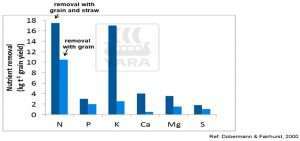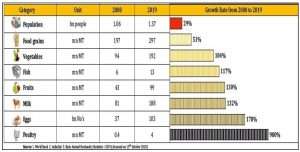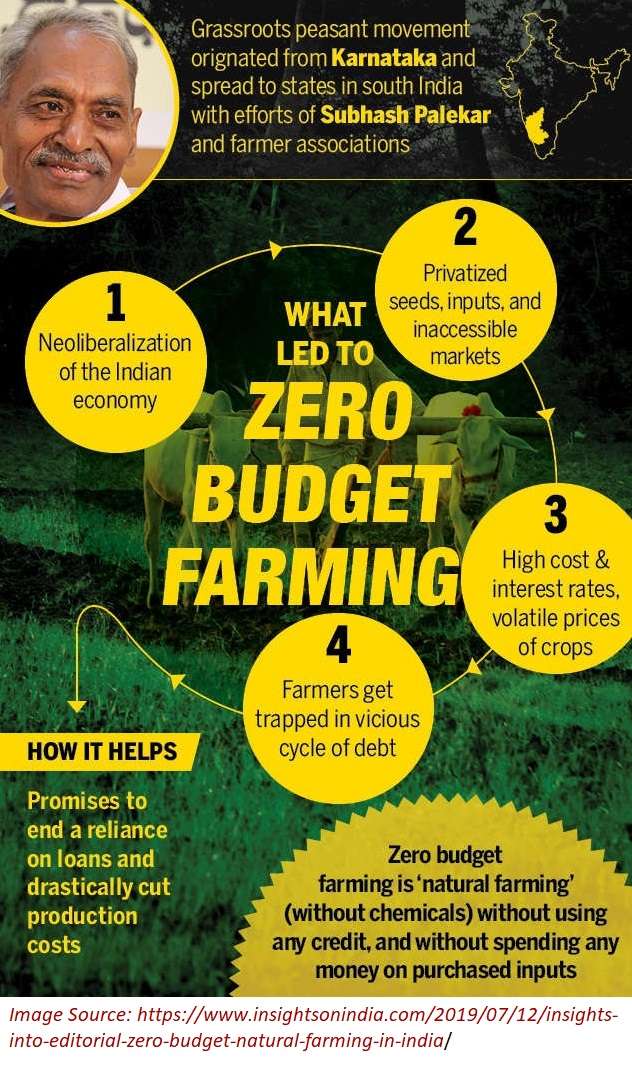In this blog, Nanditha KM and KM Sreekumar discuss the pitfalls of embracing Zero Budget Natural Farming (ZBNF), as a key strategy for agricultural development and argues for a much-informed debate on it based on scientific principles and evidence.
CONTEXT
Zero Budget Natural Farming (ZBNF) was included in 2020’s Union Budget of India as a way of increasing farmers’ income. The state governments of Andhra Pradesh and Karnataka have spent a huge sum in encouraging this technology. In Andhra Pradesh, 5.23 lakh farmers have converted 13% of agricultural land into ZBNF. The Government of Andhra Pradesh claimed that this type of farming is more climate resilient and named it as Climate Resilient ZBNF and has implemented it since 2015-16 through a not-for profit-company Rythu Sadhikar Sanstha (RySS – a farmers’ empowerment organization).[1] In Karnataka one lakh farm families are involved in it (NAAS 2019). Other Indian states are also encouraged to adopt this technology on a wider scale. ZBNF claims to encourage farmers to use low-cost locally-sourced inputs, eliminating the use of chemical fertilizers, pesticides, and without availing credit from financial institutions or local moneylenders. So it is imperative to discuss the scientific rationale of this technology in detail.
WHAT IS ZERO BUDGET NATURAL FARMING?
Padmasree Subhash Palekar is the proponent of Zero Budget Farming. After pursuing graduation in agriculture from Nagpur Agricultural College, he started working with his father on the farm with modern agricultural technology. According to Palekar, ‘when the production in his farm decreased he became demystified with modern farming and looked for alternatives. He observed that the trees in the forest yielded profusely every year without fertilizer application, whereas in the farmland addition of manures and fertilizers are essential to maintain production[2]. This made him think and he concluded that all soils contain all the necessary nutrients in the correct quantity and proportion required for plant growth but was not made available due to decreased microbial activity. So, to increase the microbial activity he proposed application of desi cow dung solution – jeevamrita – along with mulching.
The conceptual base of ZBNF contains a careful combination of Masanobu Fukuoka’s natural farming where use of paddy straw as soil mulch is practiced, and Rudolf Stainer’s biodynamic farming where spraying of diluted organic preparations over the field is followed. But Palekar denies both organic farming as well as scientific farming.[3]
| Box 1: Four Pillars of ZBNF Beejamrutham is a fermented liquid consisting of cow dung, cow urine, lime, cereal powder and some soil from the field, which is used for seed treatment. Jeevamrutha is a fermented microbial culture containing desi cow dung, cow urine, jaggery, pulse flour and a handful of soil from the farm which acts as a catalyst that promotes the activity of microorganisms in the soil. He recommends the application of jeevamrutha to the crops twice a month – either in the irrigation water or as 10% foliar spray. Mulching with fallen leaves or dried straw conserves the soil moisture and maintains the root temperature at 25-320 C. It enhances the microbial activity. He emphasised three types of mulching viz., soil mulch, straw mulch, and lime mulch. Waphasa is soil moisture in vapour form which he believes plants are able to absorb. Source: https://www.insightsonindia.com/2019/07/12/insights-into-editorial-zero-budget-natural-farming-in-india/ |
Now let us analyse the scientific basis of ZBNF’s claims and arguments.
ZBNF CLAIMS
There is no need to apply chemical fertilizers, manures, and soil ameliorants in crop fields. Apply only diluted desi cow dung as microbial mixture and mulch the fields.
Soil Fertility
Agricultural Science developed in the last 170 years. Now we know, in detail, the roles of different nutrients in plant health. Primary (Nitrogen, Phosphorus, Potassium), Secondary (Calcium, Magnesium, Sulphur), and micro nutrients (Boron, Zinc, Manganese, Molybdenum, Iron, Nickel, Copper) are essential for the growth of plants. If plants are not provided with these nutrients in accurate amounts and in correct proportions at the correct time it may lead to nutrient deficiency and low yield. The proportion of nutrients required for different crops varies. Starch-producing crops such as cereals and tubers require a high amount of potassium whereas leafy vegetables require a high amount of nitrogen.
 Figure 1. Average nutrient removal per 1t grain yield (macro nutrients)
Figure 1. Average nutrient removal per 1t grain yield (macro nutrients)
Similarly, different soil types have different ratios of nutrients in it and have its own limitations in providing all plant nutrients. For e.g., lateritic soil has a high amount of iron (Fe) and aluminum (Al) and less calcium, potassium, magnesium and boron and is highly acidic in nature. Unless the soil acidity is corrected to neutrality, all the nutrients will not be made available to the plants and Fe and Al may reach phytotoxic levels. The soils of Gujarat are alkaline and addition of gypsum is essential to bring it to neutrality, and addition of Fe will improve plant health. Contrary to Palekar’s arguments, microbes alone cannot provide all the nutrients to the soil. A few species of microorganisms can fix atmospheric nitrogen but no microorganism can produce or convert an element into another that is not available/deficient in the soil.
In this context, it will be worthwhile to examine these two questions.
Should we manure our plants?
If plants in forest can grow without the application of manure, then why should we apply it for crops? The answer is very simple. In forests, the nutrient recycling is complete. Plants immediately absorb the nutrients from dead and decomposed plant parts. Nutrient loss from the soil is minimum. But in a paddy-wheat system with a productivity of 10 t/ha, nutrient removal by way of harvest will be N:225 kg, P2O5:100 kg, K2O:315 kg, Ca:62 kg, Mg:38 kg, S:40 kg, Fe:4 kg, Mn:44 kg, Zn:400 g, B:300 g, Cu:300 g[4] (Tandon 2004). ZNBF claims that dung and urine from one desi cow can support 12 ha of land. It may be noted that one cow will give around 5 t of dung in a year which will supply 12kg N whereas the removal of N due to harvesting will be 2700 kg. Plants will show deficiency symptoms and susceptibility to pests and diseases, if the field is not replenished with nutrients, thus adversely affecting the yield. Soil testing, leaf colour chart in paddy and wheat, and index leaf analysis in other crops help in detecting these deficiencies at an early stage and its correction ensure high yield. In tree crops, the nutrient recycling is better as the roots can reach far and deep and absorb nutrients. It is a proven fact that plants absorb nutrients in inorganic form only – even if we apply organic manures. The claim that by mulching crop residues and spraying thin solution of cow dung (10 kg in 100 L water) will provide sufficient nutrients is without any evidence.
Will chemical fertilizers kill the soil?
The widespread belief, which Palekar and a few others also share, is that application of chemical fertilizers will destroy the soil properties. But, ICAR-AICRP through Long Term Fertilizer Experiments (LTFE), going on for the last 50 years in different agro-eco regions and cropping systems, have proven beyond doubt the significance of balanced fertilization (Singh and Wanjari 2017). Cui et al. (2018) reported that long-term balanced fertilizer application using manure and chemical fertilizers not only increased organic material pools and nutrient availability, but also enhanced the biodiversity of the rhizospheric bacterial community and the abundance of Actinobacteria, which contribute to the sustainable development of agro-ecosystems.
Pest Management
For pest management, Palekar developed three decoctions, namely agniastra, neemastra, and brahmastra, basically containing buttermilk, cow milk, pepper powder, neem seed, garlic and green chilli (Palekar 2016). But is this sufficient to manage all the pests? Plants may be inflicted with different diseases or pests such as fungi, phytoplasma, viruses, bacteria, nematodes, mites and insects. The above mentioned astras (see Four Pillars of ZBNF) cannot cure all types of ailments because the causative organisms are diverse. Explicit acaricides can kill phytophagous mites without damaging the plant. In the same way, antibiotics, fungicides, and pesticides can manage the pests precisely, with minimum and temporary impact on the environment. World over, this is how pests and diseases are managed currently under modern farming.
Mulching and Waphasa
ZBNF emphasises three types of mulching viz., soil mulch, straw mulch and lime mulch. Mulching has been practiced by farmers for several centuries and is also recommended by agricultural scientists sufficiently early. So there is no point in presenting mulching as a new technique. ZBNF recommended waphasa. Waphasa is the soil moisture in vapour form which Palekar believes plants are able to absorb. But science shows that the concept of waphasa is inappropriate. Plant roots cannot absorb water vapour. Studies have shown that only epiphytes can absorb water vapour through their roots.[5]
Is ZBNF more climate resilient than conventional farming?
According to Palekar, ZBNF is a low-input, climate-resilient type of farming. ZBNF crops have shown greater resilience to climate shocks than non-ZBNF crops. The article ‘Concept note on ZBNF’ states that during 2018, Andhra Pradesh had suffered from two cyclones namely Pethai and Titli. Despite heavy winds and devastation in many parts of the state, ZBNF crops were able to withstand the cyclone due to better health of the plant root system.[6]
But the statement is not supported by experimental evidence. Just showing the photographs of the healthy and damaged banana fields is insufficient to support such a claim. The article, ‘ZBNF as a nature based solution for climate actions’, states that ZBNF is reducing carbon emission and increasing carbon sequestration in the soil.[7]But no experimental data is provided on the building up of carbon in ZBNF plots over the years. Saurabh et al. (2018) made tall claims that by doing ZBNF, 17 of the Sustainable Development Goals can be achieved. But detailed reading of the document shows that all these claims are just guesswork without any experimental data or hard statistics. The design of cherry picking some case studies and making far-fetched conclusions is clearly evident.
How can agriculture be climate resilient? The Intergovernmental Panel on Climate Change (IPCC) predicts that there will be more climate-extreme events, like serious droughts or floods in the coming years resulting in severe crop loss, more outbreaks of pests and diseases, and then pests or diseases may become primary. The status of primary pests or diseases may get lowered, but nutrient deficiency syndromes may become more rampant. Untimely rains may have adverse impact on the physiology of crops. In such a situation mitigation of these impacts is important at the national level.
Development of varieties which are short duration may help in escaping from drought spells. Development of varieties by pyramiding resistant genes is a sure way of reducing pests and diseases and abiotic stress impact. Development of acidity, alkalinity and salt tolerant varieties are possible through biotechnology, without compromising on yield potential. Reducing soil acidity or alkalinity by proper amelioration and providing nutrients in an integrated manner based on soil testing will make the plant healthier with deeper root system, thus allowing them to tolerate climate change events. Deeper knowledge of plant physiology may bring solutions such as hormone application, foliar nutrition, application of chemicals like salicylic acid, etc., to overcome drought, flood, non-flowering, flower and fruit dropping, and so on. Newer irrigation methods, such as drip irrigation, have greatly increased water use efficiency. Slow release nitrogen fertilizers, such as neem coated urea, have increased fertilizer use efficiency. This shows that proper use of agricultural technologies can mitigate climate change in agriculture to a great extent – and not ZBNF. ZBNF has not been scientifically proven to be climate resilient.
Destruction of Local Culture and Human Health
Farming practices, other than ZBNF, result in destruction of local culture/human health is another perception that needs to be addressed. The arguments about destruction of local culture or human health are baseless. In the past one century period, the longevity of people in India have increased from 25 years to 70 years because of all-round development in the areas of health, agriculture, etc. (Bhagavati and Choudhary 2015). Globally high yielding varieties and hybrids form the basis for food and nutritional security. Even though Palekar rejects hybrids and HYVs, the role played by such in increasing the production of cereals, fruits and vegetables, milk, poultry and eggs cannot be denied.
 Figure 2. India – Population growth vs Agri. Production growth
Figure 2. India – Population growth vs Agri. Production growth
PROCEDURAL FORMALITIES IN THE DEVELOPMENT AND PROMOTION OF AGRICULTURAL TECHNOLOGIES
Package of practices (POP) for crops developed by the State Agricultural Universities is considered the most appropriate guide for promoting modern farming. It is the guiding document on promotion of scientific farming by the Department of Agriculture of every state in India. A technology finds a place in POP only after testing its performance through multi-locational trials and then presenting its results in the respective Zonal Research Extension Advisory Council and at the POP Workshop at state level. During the process of technology development many experiments will be conducted, data generated, analyzed and conclusions drawn. That means, technologies will be accepted based on rigorous experimentation and scientific evidence. But when it comes to ZBNF, no such exercise was done in Andhra Pradesh or Karnataka before it was officially endorsed by the Government of India. Finally, when doubts were expressed, the responsibility of testing was not entrusted to ICAR or SAUs by the AP Government but with CIRAD (Agricultural Research Centre for International Development) which is a French research centre working with developing countries and University of Reading, England.[8]
It may be noted that India has changed from a country lagging at the back of the classroom to the second best in the world in terms of value of agriculture produce because of the tireless efforts of the Indian Council of Agricultural Research (ICAR) and State Agriculture Universities. But later Niti Aayog ruled that ICAR will make an evaluation of the ZBNF system before its nationwide rollout (Economic Times, 13 July, 2020).
STUDIES ON ZBNF
The Indian Institute of Farming Systems Research (ICAR – IIFSR) at Modipuram conducted a multi-locational comparative study. In wheat-rice cropping system 59% reduction in wheat yield and 32% reduction in rice yield under ZBNF as compared to conventional farming was reported. Wheat and rice are the backbone of our food security, so, such a reduction is to be viewed very seriously (NAAS 2020).
A 3-year study by the University of Agricultural Sciences (UAS), Dharwad has shown a decrease of 30% in yield in soybean-wheat, groundnut-sorghum, and maize-chickpea cropping system, and 17% in cotton-groundnut intercropping system under ZNBF (NAAS 2020).
A study by University of Aberdeen shows that contrary to the fears of many scientists the ZBNF system could support improved food production for low input farmers. In addition, because inputs of crop residues are high, soils are unlikely to degrade. However, the maximum potential nitrogen supply is only likely to be 52 to 80% of the average fertilizer application rate. This means that yield penalties are likely in higher input system, so widespread conversion of farms from all sectors to ZBNF is not recommended (Smith 2020).
Barucha et al. (2020) made a detailed analysis of the ZBNF movement in Andhra Pradesh and compared the yield and income of farmers under ZBNF and conventional farming. ZBNF yields were higher than non-ZBNF yields across all districts, except one. All crops, except irrigated maize and irrigated cotton, consistently show higher yields under ZBNF relative to a non-ZBNF control. Costs of cultivation under ZBNF conditions were lower, and net incomes higher than non-ZBNF for all crops. Irrigated crops achieved slightly larger reductions in costs of cultivation relative to rainfed crops. This is incredible in the first year of conversion. The data they have taken for analysis was generated by RySS but it is not foolproof experimental data – thus making it undependable for drawing objective conclusions. Third party verification of the facts and figures is a part of the methodology of science which was not followed here.
Another study (Khadse et al. 2017) glorifies ZBNF as a departure from green revolution technology but remains silent about negating the methodology of science by Palekar and testing the veracity of the tall claims of ZBNF. Munster (2018) pointed out instances of rejecting and selectively embracing science and technology by Palekar. He also noted that the main reason for the spread of ZBNF among farmers of Wayanad in Kerala is mistrust of mainstream agricultural extension usually backed by strong anecdotal evidence about clueless officials, easily noticeable evidence of the ecological costs of agrochemicals, and close experiences with the financial risks of growing cash crops. Another observation by Munster (2018) is that Palekar frames his critique of the State-Capital-Science nexus in obscurantist idioms of conspiracy theories, cultural nationalism, and Hindu chauvinism. Saldanha (2018) observed that ZBNF is promoted as a miracle solution to the numerous problems of Indian agriculture but it is riddled with inconsistencies. Moreover, the term ‘Zero Budget’ implies the low cost of investment required for the farming technology but the thousands of crores of rupees that are being raised for its implementation deserve some justification as well as transparent and accountable utilization.
END NOTE
Our agricultural sector is facing lots of issues in this era of climatic extremes. We have to enhance agricultural productivity by adopting sustainable farming practices. For that, precise use of agricultural science and technology is essential. Negation of it and glorification of the old will make the farming issues more complex. ZBNF technology should be adopted only after thorough scientific examination. Promoting unproven technologies in the name of agroecology, climate resilience and biodiversity conservation is an unfair act towards the farming community. A preliminary examination of ZBNF shows that its tall claims are untenable and it is akin to the practices followed in India prior to the 1950s when the country faced severe food shortages. It is high time that the agricultural science community comes forward with courage and conviction to publicly express its concerns on promoting ZBNF. Lack of such an effort will push the country backwards by several decades.
REFERENCES
Bhagwati B and Choudhury L. 2015. Generation life table for India: 1901-1951. Middle East Journal of Age & Ageing 12:1-14.
Bharucha ZP, Mitjans SB and Pretty J. 2020. Towards redesign at scale through zero budget natural farming in Andhra Pradesh, India. International Journal of Agricultural Sustainability 18(1):1-20 DOI: 10.1080/14735903.2019.1694465.
Cui X, Zhang Y, Gao J et al. 2018. Long-term combined application of manure and chemical fertilizer sustained higher nutrient status and rhizospheric bacterial diversity in reddish paddy soil of Central South China. Scientific Reports 8:16554.
Dobermann A and Fairhurst T. 2000. Rice: Nutrient disorders & nutrient management. Handbook Series. Canada: Potash & Phosphate Institute of Canada (PPIC); and Manila, Philippines: International Rice Research Institute. 191.
Economic Times. 13 July, 2020. https://economictimes.indiatimes.com/news/ economy/ agriculture/ icar-to-study-zero-budget-farming-before-its-rollout/articleshow/70201301.cms
FAO. 2019. Workshop on Zero Budget Natural Farming (ZBNF). http://www.fao.org/india/news/detail-events/en/c/1194713/
Fertilizer Development and Consultation Organization, New Delhi. World Bank, India stat and basic animal husbandry statistics – 2019. Accessed on 13 October, 2020.
Khadse A, Rosset PM, Morales H and Ferguson BG. 2017. Taking agroecology to scale: The zero budget natural farming peasant movement in Karnataka, India. The Journal of Peasant Studies 45(1):192–219.
Munster D. 2018. Performing alternative agriculture: Critique and recuperation in zero budget natural farming, South India. Journal of Political Ecology 25.
NAAS. 2019. Zero budget farming – A myth or reality. Policy Paper 90. New Delhi: National Academy of Agricultural Sciences.
Palekar S. 2016. Zero budget natural farming. http://palekarzerobudgetspiritualfarming.org
Saldanha Leo F. A review of Andhra Pradesh’s climate resilient zero budget natural farming. Environment Support Group, October 2018.
Singh M and Wanjari RH. 2017. All India coordinated research project on long-term fertilizer experiments to study changes in soil quality, crop productivity and sustainability. Annual Report 2016-17. Bhopal: Indian Institute of Soil Science. Pp.118.
Smith J, Yeluripati J, Smith P and Nayak DR. 2020. Potential yield challenges to scale-up of zero budget natural farming. Nature Sustainability, 3:247-252.
Tandon HLS. 2004. Fertilizers in Indian agriculture – from 20th to 21st century.
Tripathi Saurabh, Shahidi Tauseef, Nagbhushan Shruti and Gupta Niti. 2018. Zero budget natural farming for the sustainable development goals, Andhra Pradesh, India. Issue brief, second edition. New Delhi: Council on Energy, Environment and Water (CEEW); and Sustainable India Finance Facility (SIFF). http://apzbnf.in/wp-content/uploads/2018/11/CEEW-ZBNF-Issue-Brief-2nd-Edition-PRINT-READY-20Sep18-min.pdf
FOOTNOTES
1. http://apzbnf.in/
2. https://www.thestatesman.com/opinion/natural-wisdom-can-save-agriculture-1502680003.html
3. https://www.insightsonindia.com/2019/07/12/insights-into-editorial-zero-budget-natural-farming-in-india/
4. N-Nitrogen, P-Phosphorous, K-Potassium, Ca-Calcium, Mg-Magnesium, S-Sulphur, Fe-Iron, Mn-Manganese, Zn-Zinc, B-Boron, C-Copper.
5. https://www.britannica.com/plant/epiphyte
6. Concept note on ZBNF https://drive.google.com/file/d/1qQkvjZ5XkeH1LkeFsqwQr7 LdRnLuQN7d/view?usp= sharing
7. https://wedocs.unep.org/bitstream/handle/20.500.11822/28895/Zerobudget.pdf
8. https://drive.google.com/file/d/1qQkvjZ5XkeH1LkeFsqwQr7LdRnLuQN7d/view
 Ms Nanditha recently completed her graduation in agriculture from Tamil Nadu Agricultural University. She can be reached at nandithakm@gmail.com
Ms Nanditha recently completed her graduation in agriculture from Tamil Nadu Agricultural University. She can be reached at nandithakm@gmail.com
 Dr KM Sreekumar, Professor, Kerala Agricultural University. He can be reached at sreekumar.km@kau.in
Dr KM Sreekumar, Professor, Kerala Agricultural University. He can be reached at sreekumar.km@kau.in





Principle of no pain no gain or nothing for nothing or trade off are forgotten in ZBNF
Thanks for an educative blog. Nanditha and Sreekumar deserve appreciation for the blog.
Two queries- a) There are many studies on Conservation Agriculture (CA). Can ZBNA be considered a variant of CA?
b) Any systematic and scientific study conducted by KAU and TNAU? ( Authors belong to these institutions and hence the question).
“Very good analysis of the ZBNF. I fully agree with the authors that any technology must be tested thoroughly by employing appropriate scientific validation procedures before promoting it. I think the data on the performance of ZBNF is insufficient to promote it on large scale. As scientists we should not forget that one of the important qualities of a scientist is “open minded and free from bias”. Congratulations to the young agriculture graduate Ms. Nanditha and Prof. Sreekumar for coming out with a useful blog”.